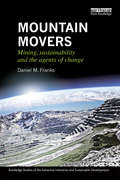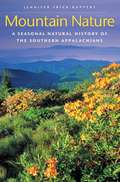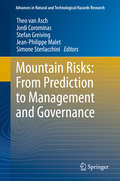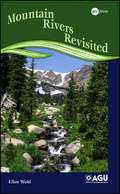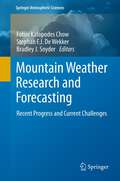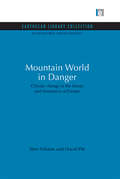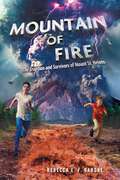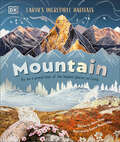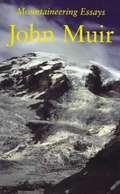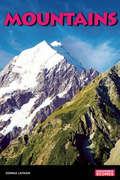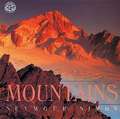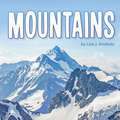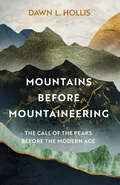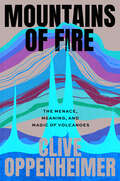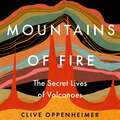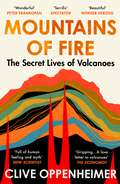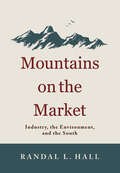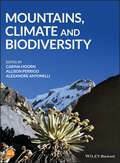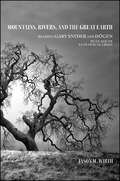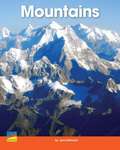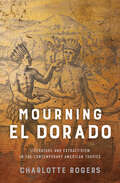- Table View
- List View
Mountain Movers: Mining, Sustainability and the Agents of Change (Routledge Studies of the Extractive Industries and Sustainable Development)
by Daniel M. FranksThe products of mining are everywhere – if it wasn’t grown, it was mined or drilled. But the mining industry has a chequered past. Pollution, human rights abuses, and corruption have tarnished the reputation of the industry across the globe. Over a decade ago the major mining companies embraced the concept of sustainable and equitable development and embarked on an explicit process of reform – but has the industry actually changed? This book explores the dynamics of change-making for sustainable development in the resources sector, specifically the mining of mineral and energy resources. The author recounts the stories and insights of over forty change-makers both inside and outside the industry, from anti-mining activists to the professionals charged with the task of reform, introducing the people who are moving an industry that moves mountains. The book takes stock of what has worked and what has not, analyzing the relative influence and dynamics of the key corporate, civil society and government actors with a view to developing new approaches for improving environmental and social outcomes from mineral and energy development. Illustrated with case studies from Angola, Australia, Brazil, Canada, Chile, Colombia, El Salvador, Guinea, Peru, The Philippines, Romania, Sierra Leone, South Africa, and The United States of America, and brimming with the backstories to the major sustainability initiatives, Mountain Movers reveals where progress has been made and where reform is still needed towards a more sustainable and equitable mining industry.
Mountain Nature
by Jennifer Frick-RuppertThe Southern Appalachians are home to a breathtakingly diverse array of living things--from delicate orchids to carnivorous pitcher plants, from migrating butterflies to flying squirrels, and from brawny black bears to more species of salamander than anywhere else in the world. Mountain Nature is a lively and engaging account of the ecology of this remarkable region. It explores the animals and plants of the Southern Appalachians and the webs of interdependence that connect them.Within the region's roughly 35 million acres, extending from north Georgia through the Carolinas to northern Virginia, exists a mosaic of habitats, each fostering its own unique natural community. Stories of the animals and plants of the Southern Appalachians are intertwined with descriptions of the seasons, giving readers a glimpse into the interlinked rhythms of nature, from daily and yearly cycles to long-term geological changes. Residents and visitors to Great Smoky Mountains or Shenandoah National Parks, the Blue Ridge Parkway, or any of the national forests or other natural attractions within the region will welcome this appealing introduction to its ecological wonders.
Mountain Risks: From Prediction to Management and Governance
by Stefan Greiving Theo Van Asch Jordi Corominas Jean-Philippe Malet Simone SterlacchiniThis book offers a cross disciplinary treatment of the rapidly growing field of integrated approaches in risk assessment in mountainous areas. All major aspects related to hazard and risk assessment, risk management, and governance are illustrated with a wide range of case studies. The first part of the book focuses on new techniques for assessing the natural hazards of different types of mass movements. State-of-the-art techniques for morphological characterization and monitoring of displacements are described. Computational advances are covered to explain the process systems and to quantify the hazards of fast and slow-moving landslides. In the second part of the book methodologies are included for assessing the impact of these natural hazards on the society in terms of risks. In this part, methodologies for defining the vulnerability of the elements at risk are shown and the use of run-out models for risk assessment of the dangerous rapid mass movements are evaluated. The third part of the book focuses on the response of society towards the problems of hazard and risk. It highlights the role of spatial planning, early warning systems and evacuation plans for risk management. It establishes practical thresholds for acceptable and tolerable risks and emphasizes the importance of education and communication to society. Audience The book is of interest to a wide range of experts from related disciplines, practitioners and stakeholders to demonstrate the importance of an integrated approach for all aspects of risks in mountainous areas.
Mountain Rivers Revisited (Water Resources Monograph #19)
by Ellen WohlPublished by the American Geophysical Union as part of the Water Resources Monograph Series, Volume 19. What are the forms and processes characteristic of mountain rivers and how do we know them? Mountain Rivers Revisited, an expanded and updated version of the earlier volume Mountain Rivers, answers these questions and more. Here is the only comprehensive synthesis of current knowledge about mountain rivers available. While continuing to focus on physical process and form in mountain rivers, the text also addresses the influences of tectonics, climate, and land use on rivers, as well as water chemistry, hyporheic exchange, and riparian and aquatic ecology. With its numerous illustrations and references, hydrologists, geomorphologists, civil and environmental engineers, ecologists, resource planners, and their students will find this book an essential resource.Ellen Wohl received her Ph.D. in geology in 1988 from the University of Arizona. Since then, she has worked primarily on mountain and bedrock rivers in diverse environments.
Mountain Weather Research and Forecasting
by Bradley J. Snyder Fotini K. Chow Stephan F.J. De WekkerThis book provides readers with a broad understanding of the fundamental principles driving atmospheric flow over complex terrain and provides historical context for recent developments and future direction for researchers and forecasters. The topics in this book are expanded from those presented at the Mountain Weather Workshop, which took place in Whistler, British Columbia, Canada, August 5-8, 2008. The inspiration for the workshop came from the American Meteorological Society (AMS) Mountain Meteorology Committee and was designed to bridge the gap between the research and forecasting communities by providing a forum for extended discussion and joint education. For academic researchers, this book provides some insight into issues important to the forecasting community. For the forecasting community, this book provides training on fundamentals of atmospheric processes over mountainous regions, which are notoriously difficult to predict. The book also helps to provide a better understanding of current research and forecast challenges, including the latest contributions and advancements to the field. The book begins with an overview of mountain weather and forecasting chal- lenges specific to complex terrain, followed by chapters that focus on diurnal mountain/valley flows that develop under calm conditions and dynamically-driven winds under strong forcing. The focus then shifts to other phenomena specific to mountain regions: Alpine foehn, boundary layer and air quality issues, orographic precipitation processes, and microphysics parameterizations. Having covered the major physical processes, the book shifts to observation and modelling techniques used in mountain regions, including model configuration and parameterizations such as turbulence, and model applications in operational forecasting. The book concludes with a discussion of the current state of research and forecasting in complex terrain, including a vision of how to bridge the gap in the future.
Mountain World in Danger: Climate change in the forests and mountains of Europe (Sustainable Development Set)
by Sten Nilsson David PittThe changing climate, the warming of the world and acid rain are among the greatest problems facing us at the end of the twentieth century. This book describes, for the first time, the effects of these phenomena on the high mountains and the forests of Europe. Mountains and the frozen regions (the cryosphere) not only play a major part in our climatic system, but are also central to our water supplies. Yet our glaciers are shrinking, our lakes and soils are becoming acidified, our forests are damaged and the whole fragile ecosystem of ranges like the Alps and the Caucasus is threatened. Nilsson and Pitt present the evidence and assess the probable effects of these changes on mountain society, tourism, water, flora and fauna. They also examine the uncertainties. Above all they look, too, at the best possible strategies in response to What is happening and at what the next steps should be. Originally published in 1991
Mountain of Fire: The Eruption and Survivors of Mount St. Helens
by Rebecca E. BaroneMountain of Fire is the narrative nonfiction account of the violent volcanic eruption of Mount St. Helens on May 18, 1980, the story of the people who died, those who survived, and the heroes who fought to raise an alarm.For weeks, the ground around Mount St. Helens shuddered like a dynamite keg ready to explode. There were legends of previous eruptions: violent fire, treacherous floods, and heat that had scoured the area. But the shaking and swelling was unlike any volcanic activity ever seen before. Day and night, scientists tried to piece together the mountain’s clues—yet nothing could prepare them for the destruction to come. The long-dormant volcano seethed away, boiling rock far below the surface. Washington’s governor, Dixie Lee Ray, understood the despair that would follow from people being forced from their homes. How and when should she give orders to evacuate the area? And would that be enough to save the people from the eruption of Mount St. Helens?Includes a QR code for a website featuring eye-catching photos of the eruption.
Mountain: Go On a Grand Tour of the Highest Places on Earth (Earth's Incredible Habitats)
by DKThis stunning book all about mountains takes children on a grand tour of the highest places on Earth.From the salt flats of the Andes to the snow-capped peak of Mount Fuji, discover 14 of the world’s most spectacular mountains and mountain ranges, and the animals and plants that live in them. The chapters cover four different types of mountains: plateaus, volcanoes, mountain ranges, and tepuis, with a selection of both famous and less-well known places within each. Every mountain or range is explored in detail, with intriguing information about its geography and flora and fauna, alongside detailed photography and beautiful illustrations. Marvel at the Great Aletsch Glacier flowing down the Alps, mountain goats scrambling across cliff faces in the Rockies, and the tiny saltwort flowers that bloom 20,000 feet up in the Himalayas. As well as the wonders of these remote areas, the threats facing mountains and their species are also investigated.Habitat: Mountains will be treasured for years to come. With foil on the cover and colorful sprayed edges, this book makes the perfect gift for any child with a passion for the natural world.
Mountaineering Essays
by John MuirThis volume contains eleven mountaineering essays that include both adventurous narrative, joyful exultation, and descriptive features such as alpine soil beds, ancient and living glaciers, and mountain sculpture. In each, Muir maintains a careful and subtle balance between the physical aspects of ascending and the more symbolic observations of the sublimity of his surroundings.
Mountains
by Donna LathamInvestigating a variety of biomes and today's natural and human threats to their preservation, this interactive series challenges young readers to look at how their own actions influence the planet's health. Four distinct environments are explored in detail, showcasing the assortment of plants and animals that inhabit these outdoor communities as well as how they have adapted to their surroundings. Offering fascinating facts on each ecosystem along with vocabulary-building sidebars, these guides show budding scientists how they can contribute towards ongoing conservation efforts. The majesty of the earth's alpine biome is captured in this guide that discusses threats such as acid rain, climate change, and habitat destruction, clearly depicting how these factors affect the world's mountains.
Mountains
by Seymour Simon"In the trademark Simon style, carefully selected color photos, drawings, and a clear and informative text tell the story of Earth's mountains: their formation, relative sizes, ecology, and influence on weather. . . . Simon may have done more than any other living author to help us understand and appreciate the beauty of our planet and our universe;
Mountains (Earth's Landforms)
by Lisa J. AmstutzLook up! All mountains rise high into the sky, but there is more to these landforms than meets the eye! Some form when two pieces of Earth's crust push up land. Erupting volcanoes form others. Some are growing, while others are shrinking. Give beginning readers all the need-to-know information about mountains, including their characteristics, how they form, and where they can be found around the world.
Mountains Hills and Cliffs (Rigby PM Plus Blue (Levels 9-11), Fountas & Pinnell Select Collections Grade 3 Level Q)
by Jan AndersonMountains, Hills, and Cliffs by Jan Anderson
Mountains before Mountaineering: The Call of the Peaks before the Modern Age
by Dawn L. HollisToday, mountains are spaces for adventure: treasured places for people to connect with nature, encounter the sublime and challenge themselves, whether it be skiing in the Italian Alps or scaling the heights of the Matterhorn in Switzerland. Some regard our love of mountains as relatively new, claiming that before modern mountaineers planted flags upon the peaks, the average European was more likely to revile and avoid a mountainous landscape than to admire it.Mountains Before Mountaineering tells a different narrative. It reveals the way mountains inspired curiosity and fascination and how they were enjoyed in sixteenth- and seventeenth-century Europe. It gives voice to the early modern travellers who climbed peaks and passes with fear and delight; to the ‘real mountaineers’ who lived and died upon the mountain slopes; and to the scientists who used mountains to try to understand the origins of the world.This book invites you on a journey through the mountains, long before Everest was ‘discovered’ as the highest mountain in the world or before the first recorded ascent of Mont Blanc. It is the story of how our love of the mountains has been a part of us from the very beginning.
Mountains of Fire: The Menace, Meaning, and Magic of Volcanoes
by Clive OppenheimerMeeting with volcanoes around the world, a volcanologist interprets their messages for humankind. In Mountains of Fire, Clive Oppenheimer invites readers to stand with him in the shadow of an active volcano. Whether he is scaling majestic summits, listening to hissing lava at the crater’s edge, or hunting for the far-flung ashes from Earth’s greatest eruptions, Oppenheimer is an ideal guide, offering readers the chance to tag along on the daring, seemingly-impossible journeys of a volcanologist. In his eventful career as a volcanologist and filmmaker, Oppenheimer has studied volcanoes around the world. He has worked with scientists in North Korea to study Mount Paektu, a volcano name sung in national anthems on both sides of the Demilitarized Zone. He has crossed the Sahara to reach the fabled Tiéroko volcano in the Tibesti Mountains of Chad. He spent months camped atop Antarctica’s most active volcano, Mount Erebus, to record the pulse of its lava lake. Mountains of Fire reveals how volcanic activity is entangled with our climate and environment, as well as our economy, politics, culture, and beliefs. These adventures and investigations make clear the dual purpose of volcanology—both to understand volcanoes for science’s sake and to serve the communities endangered and entranced by these mountains of fire.
Mountains of Fire: The Secret Lives of Volcanoes
by Clive OppenheimerA thrilling journey to the planet's most extreme places with volcanologist and filmmaker Professor Clive Oppenheimer, revealing how volcanoes have shaped us and our planet.Volcanoes mean more than threat and calamity. Like our parents, they've led whole lives before we get to know them. They have inspired our imaginations, provoked pioneering explorations and shaped the path of humanity.World-renowned volcanologist Clive Oppenheimer has worked at the crater's edge in the wildest places on Earth, from remote peaks in the Sahara to mystical mountains in North Korea. He's faced down AK47s, learned from tribal elders, and watched red hot rocks shoot into the sky. More people have been into space than have set eyes on the fiery depths of Mount Erebus in Antarctica, where he has measured the Earth's powerful forces. In Mountains of Fire, he paints volcanoes as otherworldly, magical places where our history is laid bare, and shows us just how entangled volcanic activity is with our climate, economy, politics, culture and beliefs.In a stunning blend of science, cultural history, myth and adventure, Mountains of Fire pulls out new lines of causation and correlation stretching around the globe, and reveals how deeply our stories are intertwined.(P) 2023 Hodder & Stoughton Limited
Mountains of Fire: The Secret Lives of Volcanoes
by Clive OppenheimerSHORTLISTED FOR THE BOARDMAN TASKER AWARD FOR MOUNTAIN LITERATURE'If Michael Palin had been a volcanologist, this is the book he would have written' LITERARY REVIEW'Gripping' THE ECONOMIST'Wonderful' PETER FRANKOPAN'Like a thriller ... This is terrific' SPECTATOR'Beautiful ... bursting with poetry, with storytelling' WERNER HERZOGWe are made of the same stuff as the breath and cinders of volcanoes. No matter where we live on the planet, they have shaped our history and might one day decide our destiny.World-famous volcanologist Clive Oppenheimer has worked at the crater's edge in the wildest places on Earth, close enough to feel the heat of the lava. In Mountains of Fire we join him on hair-singeing adventures from Italy to Antarctica to learn how deeply our stories are intertwined with volcanoes.
Mountains on the Market: Industry, the Environment, and the South (New Directions In Southern History Ser.)
by Randal L. Hall“This is a landmark not only of Appalachian history but of southern economic and environmental history as well.” —John C. Inscoe, author of Race, War, and Remembrance in the Appalachian SouthManufacturing in the Northeast and the Midwest pushed the United States to the forefront of industrialized nations during the early nineteenth century; the South, however, lacked the large cities and broad consumer demand that catalyzed changes in other parts of the country. Nonetheless, in contrast to older stereotypes, southerners did not shun industrial development when profits were possible. Even in the Appalachian South, where the rugged terrain presented particular challenges, southern entrepreneurs formed companies as early as 1760 to take advantage of the region’s natural resources.In Mountains on the Market: Industry, the Environment, and the South, Randal L. Hall charts the economic progress of the New River Valley in the Blue Ridge Mountains of southwestern Virginia, which became home to a wide variety of industries. By the start of the Civil War, railroads had made their way into the area, and the mining and processing of lead, copper, and iron had long been underway. Covering 250 years of industrialization, environmental exploitation, and the effects of globalization, Mountains on the Market situates the New River Valley squarely in the mainstream of American capitalism.“Southernists will now refer to this book first in thinking about the historical development of the extractive industries, their impact on the environment, and what it tells us about the South.” —David Brown, coauthor of Race in the American South: From Slavery to Civil Rights“An excellent microhistory of an understudied region of the Appalachian South.” —North Carolina Historical Review
Mountains, Climate and Biodiversity
by Carina Hoorn Allison Perrigo Alexandre AntonelliMountains, Climate and Biodiversity: A comprehensive and up-to-date synthesis for students and researchers Mountains are topographically complex formations that play a fundamental role in regional and continental-scale climates. They are also cradles to all major river systems and home to unique, and often highly biodiverse and threatened, ecosystems. But how do all these processes tie together to form the patterns of diversity we see today? Written by leading researchers in the fields of geology, biology, climate, and geography, this book explores the relationship between mountain building and climate change, and how these processes shape biodiversity through time and space. In the first two sections, you will learn about the processes, theory, and methods connecting mountain building and biodiversity In the third section, you will read compelling examples from around the world exploring the links between mountains, climate and biodiversity Throughout the 31 peer-reviewed chapters, a non-technical style and synthetic illustrations make this book accessible to a wide audience A comprehensive glossary summarises the main concepts and terminology Readership: Mountains, Climate and Biodiversity is intended for students and researchers in geosciences, biology and geography. It is specifically compiled for those who are interested in historical biogeography, biodiversity and conservation.
Mountains, Rivers, and the Great Earth: Reading Gary Snyder and Dōgen in an Age of Ecological Crisis (SUNY series in Environmental Philosophy and Ethics)
by Jason M. WirthFINALIST for the 2017 Foreword INDIES Book of the Year Award in the Philosophy categoryMeditating on the work of American poet and environmental activist Gary Snyder and thirteenth-century Japanese Zen Master Eihei Dōgen, Jason M. Wirth draws out insights for understanding our relation to the planet's ongoing ecological crisis. He discusses what Dōgen calls "the Great Earth" and what Snyder calls "the Wild" as being comprised of the play of waters and mountains, emptiness and form, and then considers how these ideas can illuminate the spiritual and ethical dimensions of place. The book culminates in a discussion of earth democracy, a place-based sense of communion where all beings are interconnected and all beings matter. This radical rethinking of what it means to inhabit the earth will inspire lovers of Snyder's poetry, Zen practitioners, environmental philosophers, and anyone concerned about the global ecological crisis.
Mountains: A True Book
by Larry Dane BrimnerDescribes what mountains are, how they are formed, what kinds of plants and animals live on them, and how they affect the surrounding weather.
Mountains: Physical, Human-Environmental, and Sociocultural Dynamics
by Mark A. FonstadMountains have captured the interests and passions of people for thousands of years. Today, millions of people live within mountain regions, and mountain regions are often areas of accelerated environmental change. This edited volume highlights new understanding of mountain environments and mountain peoples around the world. The understanding of mountain environments and peoples has been a focus of individual researchers for centuries; more recently the interest in mountain regions among researchers has been growing rapidly. The articles contained within are from a wide spectrum of researchers from different parts of the world who address physical, political, theoretical, social, empirical, environmental, methodological, and economic issues focused on the geography of mountains and their inhabitants. The articles in this special issue are organized into three themed sections with very loose boundaries between themes: (1) physical dynamics of mountain environments, (2) coupled human–physical dynamics, and (3) sociocultural dynamics in mountain regions. This book was first published as a special issue of the Annals of the American Association of Geographers.
Mourning El Dorado: Literature and Extractivism in the Contemporary American Tropics (New World Studies)
by Charlotte RogersWhat ever happened to the legend of El Dorado, the tale of the mythical city of gold lost in the Amazon jungle? Charlotte Rogers argues that El Dorado has not been forgotten and still inspires the reckless pursuit of illusory wealth. The search for gold in South America during the colonial period inaugurated the "promise of El Dorado"—the belief that wealth and happiness can be found in the tropical forests of the Americas. That assumption has endured over the course of centuries, still evident in the various modes of natural resource extraction, such as oil drilling and mining, that characterize the region today.Mourning El Dorado looks at how fiction from the American tropics written since 1950 engages with the promise of El Dorado in the age of the Anthropocene. Just as the golden kingdom was never found, natural resource extraction has not produced wealth and happiness for the peoples of the tropics. While extractivism enriches a few outsiders, it results in environmental degradation and the subjugation, displacement, and forced assimilation of native peoples. This book considers how the fiction of five writers—Alejo Carpentier, Wilson Harris, Mario Vargas Llosa, Álvaro Mutis, and Milton Hatoum—criticizes extractive practices and mourns the lost illusion of the forest as a place of wealth and happiness.
Move: How Mass Migration Will Reshape the World – and What It Means for You
by Parag KhannaWhere will you live in 2030? Where will your children settle in 2040? What will the map of humanity look like in 2050?In the 60,000 years since people began colonising the continents, a recurring feature of human civilisation has been mobility - the constant search for resources and stability. Seismic global events - wars and genocides, revolutions and pandemics - have only accelerated the process. The map of humanity isn't settled, not now, not ever.As climate change tips toward full-blown crisis, economies collapse, governments destabilise and technology disrupts, we're entering a new age of mass migrations - one that will scatter both the dispossessed and the well-off. Which areas will people abandon and where will they resettle? Which countries will accept or reject them? As today's world population, which includes four billion restless youth, votes with their feet, what map of human geography will emerge?Here global strategy advisor Parag Khanna provides an illuminating and authoritative vision of the next phase of human civilisation - one that is both mobile and sustainable. As the book explores, in the years ahead people will move to where the resources are and technologies will flow to the people who need them, returning us to our nomadic roots while building more secure habitats. Move is a fascinating look at the deep trends that are shaping the most likely scenarios for the future. Most importantly, it guides each of us as we determine our optimal location on humanity's ever-changing map.
